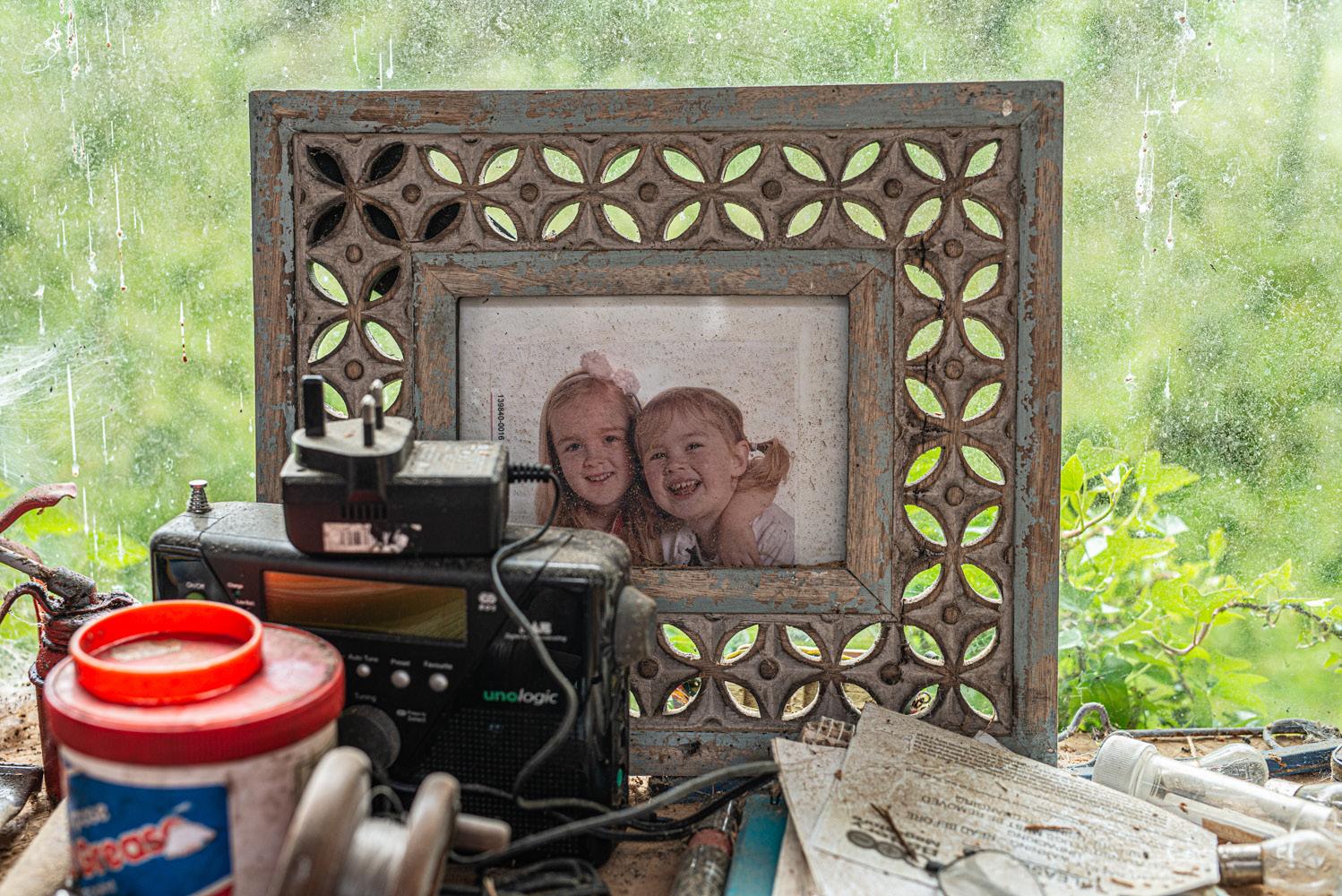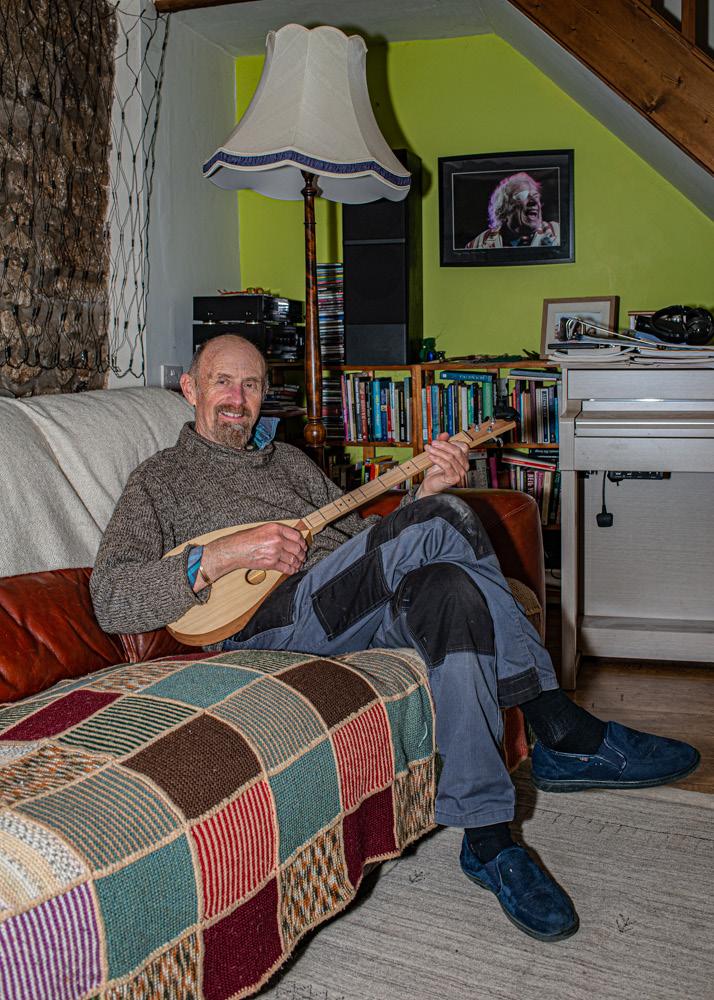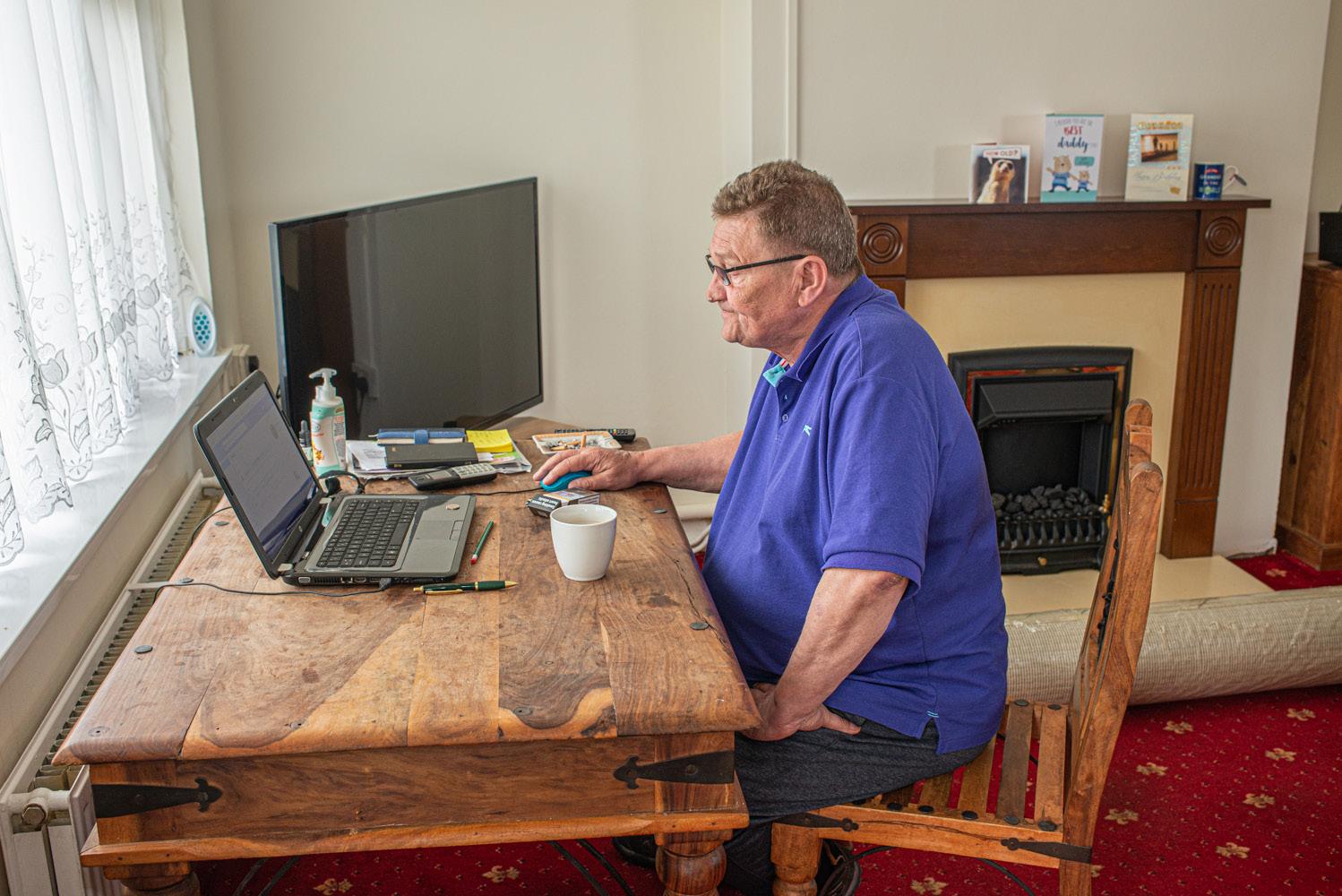
8 minute read
Sofa to Shed - Ray Hobbs ARPS
The abstraction of my Sofa to Shed project is a photographic enquiry into the lives and journeys of four men from their homes into the community of a Men’s Shed. The subjects of my project, Sofa to Shed, all consented to be photographed and to articulate, on video, their journeys from isolation, loneliness, and depression, to a “shed”.
Advertisement
Research for this project revealed the extent of the hidden condition that many men live with. I was ill prepared for my emotional roller coaster journey and for what I was about to discover. Subsequently it became incumbent upon me to represent empathetically those men who courageously and generously agreed to participate in my project.
Decisively, the physical Men’s Shed has not been photographed; the colloquial term “shed” is used to describe a community of men who generally associate in a physical workspace or shed. Through research into the wider community, I frequently observed men in gatherings of two or more. It was this surveillance that implied the term shed could be applied to a park bench or peloton of male cyclists, or any location where men associated. For my project, a shed, or community space, does not necessarily need four walls, a roof, and a workbench.

Whenever I met Glen he always seemed so disengaged with the world, with life. Just staring into nothingness.
Ray Hobbs ARPS

Glen spends all of his days sitting at the window, commenting to himself about the neighbours.
Ray Hobbs ARPS

Glen surrounds himself with memories if his family, with children’s toys for rarely seen kids. In the family group shots, Glen can be seen as a very happy and smiling man; he doesn’t smile anymore.
Ray Hobbs ARPS

Glen has a disability scooter, which is trapped and hidden away, a metaphor for his life?
Ray Hobbs ARPS
Whenever I plan a project, I conduct extensive research through library books and internet searches, my personal book collection or specifically purchased literature. I produce a proposal with visuals including a to-do list with timelines and frequently a storyboard. I visualise scenarios with my subjects and consider what lighting and camera equipment will be most appropriate. I also advance-plan a printing schedule, exhibition venues and a detailed, costed, marketing plan for press releases and personal invitations – both by email and invitation cards.
For Sofa to Shed my research included the purchase of the print-to-order book The Men’s Shed Movement: The Company of Men by Professor Barry Golding. Interestingly, although everyone in the Welsh Sheds was aware of it, no-one had a copy. This 433-page book details the establishment of sheds in Australia in 2008. The book represents the only clear and precise compendium of sheds worldwide with detailed information on particular countries including the UK and Republic of Ireland.
However, despite all my extensive preparation and planning, I am well aware that much of the preparation could prove to be redundant as the project unfolds and circumstances change, but this planning is of immeasurable significance to me to prepare for the project, to get my mind and energy focused and to be aware of possible failures and alternate scenarios. I plan to succeed.
The Sofa to Shed project is an excellent example of a proposal veering totally off course during the initial stages of the project commencement. My preliminary considerations were to portray the companionship and camaraderie engendered in the sheds by producing environmental portraits and team participation project activities. However, it soon became clear that all of the men had very personal and emotional journeys taking them from isolation and loneliness into the community of a shed. I reconsidered a narrative of articulating the stories of individual men and their journeys into a friendly, non-judgemental, participatory environment where life stories, problems and journeys can be shared over a workbench and a cup of tea.

Richard has a well-equipped workshop, which is the envy of many men; but this doesn’t compensate for his loneliness.
Ray Hobbs ARPS

Richard is adept at creating highly complex musical instrument such as a Dulcimer.
Ray Hobbs ARPS

Amongst the wood dust and shavings in his workshop is this photo of his grandchildren.
Ray Hobbs ARPS

During our interview, Richard sang to me.
Ray Hobbs ARPS
My project consists of a series of environmental portraits of each of my subjects on their sofas and in their home settings, signifying the commencement of a journey from their sofa to a shed providing a community, and a refuge. The men were all remarkably candid and open about personal difficulties in their lives that had been overcome or reduced by involvement in sheds and the ability to articulate their personal stories to like-minded men. Without exception, all the men I approached agreed to filmed interviews, which took place on their sofas.
To a large extent this project took on its own direction. As the stories of the individual men unfolded it became clear that I was in uncharted waters regarding interpretation and the presentation of their harrowing stories. I have learnt a lot about me and my photography and a possible direction for my documentary career.
As I was still recovering from a recent heart attack and experiencing bouts of extreme fatigue, I decided to keep my project capture area within a reasonable travelling distance of 60 miles, which could include the town of Carmarthen and the city of Cardiff.
All four of the collaborative participants had a comparable, but very distinctive story to disclose. An unanticipated and somewhat overwhelming outcome of the powerful and personal interviews has been the effect on me. Also, the impression of an intense deep feeling of connection between some of my interviewees and me as a “confidant”, for which I was not qualified or prepared for.

Robert is a great, friendly and affable character, but suffers terribly from depression.
Ray Hobbs ARPS

His life seems very hard and uncompromising. He still smokes even though he has the lung disease COPD. The new rolled-up carpet has been sitting there for months waiting for him to do something. Adjacent to the new carpet is an unused rowing machine.
Ray Hobbs ARPS

Mission control. Scattered around his house, Robert has several pieces of gym equipment. In his bedroom there is a jogging machine performing the role of a trouser press.
Ray Hobbs ARPS

Included in his collection of gym equipment is this stationary cycle. Robert has membership of a local gym, which he has never used.
Ray Hobbs ARPS
The project included video recordings of three of the four men and an essay by Robert who described his ‘pit of despair’ and thoughts of suicide as he was unable to discuss his depression at work for fear of ‘discrimination’. Stephen described on video how the realisation of his impending blindness drove him to seriously contemplate ending his life. He acknowledged that speaking on video was the first time that he had articulated his consideration of suicide, during which interview he cried. He admitted that collaborating with me on Sofa to Shed had enabled him to reassess his life and be more positive about his future. Stephen has now gone onto establishing a bowls club for partially sighted people in Llanelli and is now running the Llanelli Men’s Shed.
Glen described his mental breakdown as a result of a catastrophic family break-up due to his life-long disability, and his wife’s alcoholism, with the resultant loss of his children. Glen admitted that even with the Shed membership he still feels lonely but has benefited greatly from it. He described how the men in the Shed provided comradeship and how this has sustained him and enabled him to cope with his depression.
Richard was 71 years old when I interviewed him. He described his work ethic and the rise and fall of his career and redundancy during the Thatcher era. He described in great detail his life in the jewellery quarter in Birmingham and the enjoyment he gained working in teams. Although Richard has a wonderful wife and house in the country, he admitted to feeling ‘lonely’. Richard revealed that his association with the Men’s Shed Cymru movement has greatly helped him to relive the camaraderie of his early working life in Birmingham and reduce his feelings of loneliness.

Stephen has the luxury of a leather sofa in his workshop.
Ray Hobbs ARPS

Due to his sight loss, Stephen can only work with larger pieces of wood. His condition has created a chasm between him and that which gives him so much joy and fulfilment.
Ray Hobbs ARPS

Stephen said that this is the only plane that he can use, because he can feel its orientation and it fits well into the palm of his hand. Anything larger he has no control over.
Ray Hobbs ARPS

Just like every man in his shed, Stephen has all those ‘come in useful items’, even if he never uses them.
Ray Hobbs ARPS
Sofa to Shed has been shown in a Cardiff gallery and was attended by representatives of the Older People’s Commissioner for Wales, Age Cymru, Men’s Sheds Cymru, Nia Griffith MP and many other interested organisations. An exhibition was also scheduled at the Senedd Cymru in support of the Men’s Health forum, but that and two other exhibitions were cancelled due to Covid-19 restrictions. As part of my marketing campaign, I contacted the BBC who interviewed Stephen and me and produced this article: Sofa to Shed. It was a privilege to tell the stories of these courageous men, but with that comes incredible responsibility to faithfully and respectfully represent their narratives.
I created a contextual introduction to my Men’s Sheds Cymru exhibition. I produced a 6,000-word report on the Men’s Sheds movement, which included details of its origins in Australia and a copy of The Company of Men by Professor Barry Golding for reference, this describes the Men’s Shed Movement. I also included samples of workshop tools, an Artist’s Statement and a pair of Men’s Sheds mugs. I fabricated the report folder from old pieces of plywood, a cleat, an odd piece of string and an off cut of leather and some wadding to represent a sofa.
I included a wall mounted photograph of two mugs to convey the philosophy of Men’s Sheds by suggesting that it takes two to make a conversation and no matter if your mug is half full or half empty, or your colour; you are welcome.
In addition to the 16 A2 prints, I produced videos of the collaborative participants, which were only accessible with headphones to maintain a sense of discretion. I placed 40 incidental 5x4 photographs around the gallery, on shelves and pinned to the walls. Member of Parliament, Nia Griffith opened my exhibition, which was attended by representatives of The Older People’s Commissioner for Wales, Age Cymru, MIND, participants and other interested relevant organisations, also friends, colleagues and family.

Ray Hobbs ARPS

Ray Hobbs ARPS






